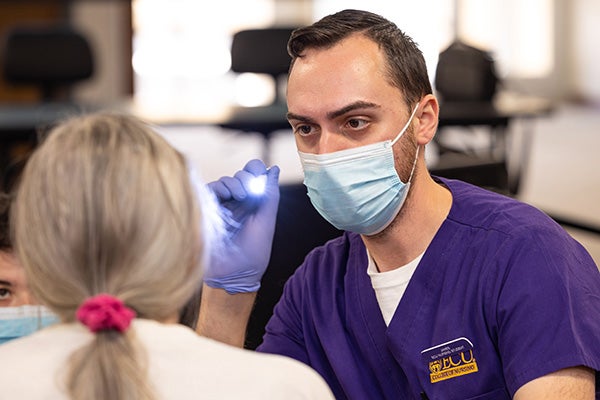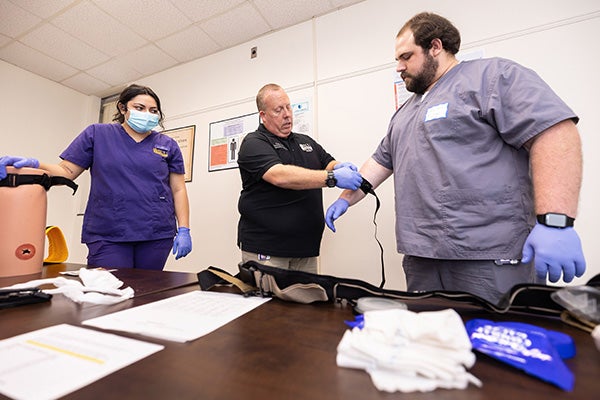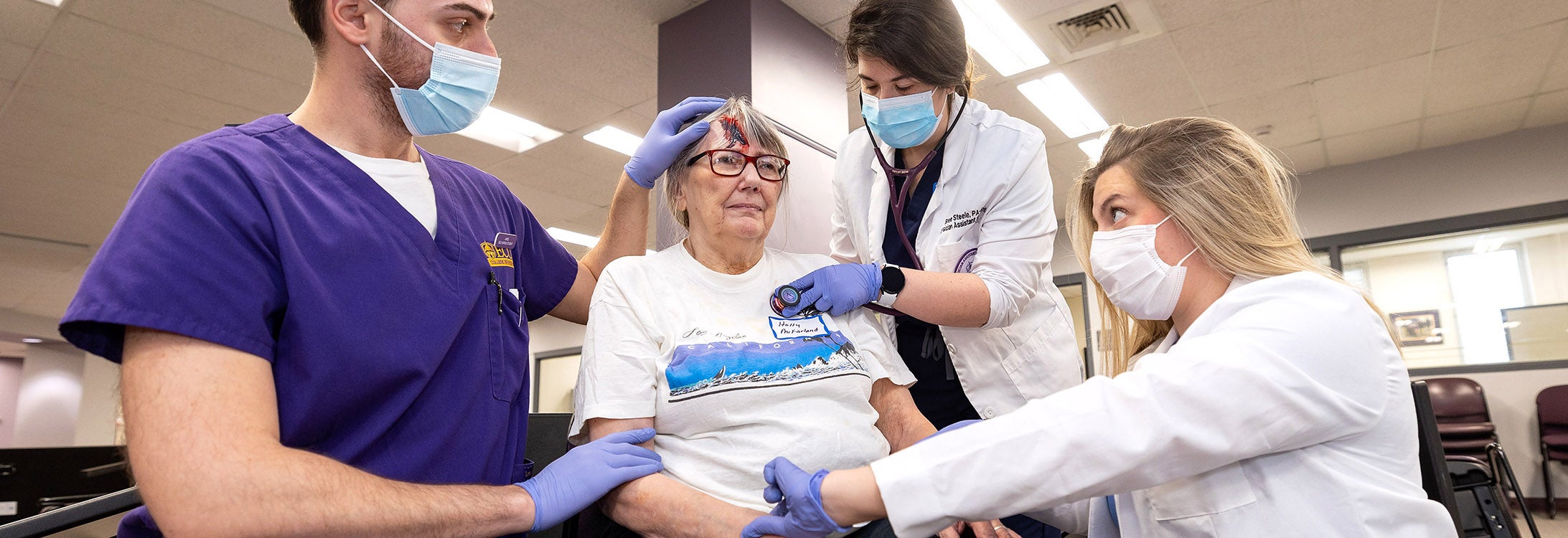EMERGENCY TRAINING
Health Sciences students join forces for interprofessional medical emergency training
The bleeding mannequins, the cries of ‘help me, help me,’ and the eyeball drooping from an actor’s face? Not real.
But the learning was.
On a beatific fall day, more than 30 students from across East Carolina University’s Health Sciences Campus — including students from the Brody School of Medicine, the College of Nursing and the College of Allied Health Sciences’ Department of Physician Assistant Studies — gathered to learn how emergency medicine works in practice, with a specific focus on integrating the unique skills of each medical specialty.
The scenario for the Interprofessional Triage and Emergency, Assessment and Management Day on Nov. 12 was all too plausible: a bomb exploded during a football game at Dowdy-Ficklen stadium. The injured were strewn about — the elderly, a pregnant woman, children. All were confused. Many were agitated. Some were dead.

Orefice attends to a victim during the mock disaster drill.
The challenge for the student members of ECU’s Emergency Medical Interest Group — including medical, nursing and physician assistant students — was simple: work together to help bring order to chaos.
Bree Belmonte, a second-year PA student from Raleigh, said that the scenario and the simulation that was created by actors, who were made up by students from the ECU School of Theatre and Dance with gruesome wounds, replicated the confusion that she expects would occur in a real-life medical emergency.
“We knew that we were in pairs, we knew that we were sorting people, but once you start getting in the lights, in the dark and people are coming up to you shouting it gets very difficult very quickly,” Belmonte said. “I think our professors have done a really good job of preparing us to enter an emergency scenario and help people.”
Arden Vessie, a second-year medical student from Clayton, worked for several years as an EMT before attending Brody and was familiar with the Incident Command System structure. The simulation was a helpful reminder of the skills needed to be effective as a health care provider during a medical emergency.
“It’s been a while since I’ve actually employed those skills, so this was a really good refresher, to be able to remind myself, not only how to do this, by why this is important to learn,” Vessie said.
Vessie hopes one day to oversee the management of a community EMS system as the medical director, which makes training opportunities like this valuable.
Putting learning to practice
Dr. Roberto Portela, an emergency medicine physician at ECU Health and the Emergency Medical Services medical director for Pitt County, said simulations can help students with limited practical skills put book learning into practice, but classroom learning is different from real world experience.
“Unfortunately, it is chaotic,” Portela said. “All of those triage things we teach sound reasonable when we are teaching them, but it doesn’t put the humanity into it, it doesn’t take the environment and the carnage that actually happens.”

Medical sciences students practice emergency medical treatment skills prior to a mock disaster drill.
The student organizers of the ITEAM training and simulation events from the Emergency Medicine Interest Group organized the day to maximize opportunities for students from different medical training programs to learn from one another.
“This event helps to develop interprofessionalism with the PAs and RNs, which I’ve not had a lot of chances to work with, so it’s cool to see their perspectives,” said Hayley Behm, a second-year medical student and vice president of Brody School of Medicine’s Emergency Medicine Interest Group. “Everyone is taught a different way to look at medicine as a whole. It’s interesting to see the way that different specialties think and using their skills to fine tune mine.”
James Orefice, a third semester nursing student from New Jersey, said the training gave him an opportunity to assess the whole patient, which is a hallmark of nursing education and practice.
“It was really cool because we had never really done anything like this through nursing school. It was definitely a different experience and interesting to learn skills that we haven’t ever touched,” Orefice said.
Rachel Stiglitz, also a second-year medical student and president of the Emergency Medicine Interest Group, had previously worked as an EMT said the simulation felt somewhat comfortable based on her background. This time, though, she was able to practice the interprofessional skills that will be required after graduation.
“We don’t have a lot of time to work alongside a PA or RN until we are in our jobs, so this is a great opportunity to be able to do that,” Stiglitz said. “Emergency medicine is a team sport, so it was nice to use this team effort to learn.”
Vessie agreed that working with other students who weren’t her peers at Brody was refreshing and eye opening.
“It’s valuable to have experiences like this early in your didactic education, as any kind of health sciences student, to learn to work better as a team,” Vessie said. “Every profession, and every person within that profession, is going to have a different skill set, and that’s a strength, not a weakness. The nurses can get an IV like that, and it’s not really part of my repertoire yet. It was amazing to work with our PA and nursing colleagues to see how our skills sets are similar and how they differ.”
